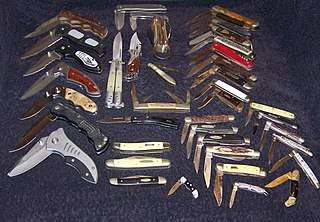 W
WA pocketknife is a foldable knife with one or more blades that fit inside the handle that can still fit in a pocket. It is also known as a jackknife (jack-knife) or a penknife, though a penknife may also be a specific kind of pocketknife. A typical blade length is 5 to 15 centimetres. Pocketknives are versatile tools, and may be used for anything from opening an envelope, to cutting twine, slicing a piece of fruit or even as a means of self-defense.
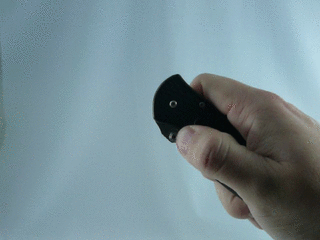 W
WAn assisted-opening knife is a type of folding knife which uses an internal mechanism to finish the opening of the blade once the user has partially opened it using a flipper or thumbstud attached to the blade.
 W
WA balisong, also known as a fan knife, butterfly knife or Batangas knife, is a folding pocketknife from the Philippines. Its distinct features are two handles counter-rotating around the tang such that, when closed, the blade is concealed within grooves in the handles. A latch holds the handles together, typically mounted on the one facing the cutting edge.
 W
WA ballpoint pen knife is a multi-tool pocket knife consisting of a blade concealed inside an ordinary-looking ballpoint pen. The blade, typically 51 to 127 millimetres in length, is usually hidden. They first appeared as custom-made pens from various custom knife makers before being mass-produced by production companies.
 W
WThe Commander (knife) is a large recurve folding knife made by Emerson Knives, Inc. that was based on a custom design, the ES1-M, by Ernest Emerson that he originally built for a West Coast Navy SEAL Team. It was winner of the Blade Magazine Overall Knife of the Year Award for 1999.
 W
WThe CQC-6 or Viper Six is a handmade tactical folding knife with a tantō blade manufactured by knifemaker Ernest Emerson. Although initially reported as the sixth design in an evolution of fighting knives and the first model in the lineup of Emerson's Specwar Custom Knives, Emerson later revealed that the knife was named for SEAL Team Six. It has a chisel-ground blade of ATS-34 or 154CM stainless steel and a handle made of titanium and linen micarta. The CQC-6 is credited as the knife that popularized the concept of the tactical folding knife.
 W
WThe douk-douk is a French-made pocket knife of simple sheet-metal construction. It has been manufactured by the M. C. Cognet cutlery firm in Thiers, France, since 1929.
 W
WA higonokami (肥後守) is a type of folding pocket knife originating in Miki, Hyōgo Prefecture, Japan in 1896. The knife has no locking system, but is a friction folder or "penny knife", using the friction of the swivel or the pressure of the user's thumb on its iconic lever or chikiri, to prevent the knife from folding during use. The handle of the Higonokami is made of a folded over sheet of metal. The handle is stamped with the name of the maker of the knife and the steel used in the blade. A distinguishing feature is that the blade has a flat grind without a secondary bevel.
 W
WThe Linerlock is a locking mechanism for folding pocket knives. A Linerlock is a folding knife with a side-spring lock that can be opened and closed with one hand without repositioning the knife in the hand. The lock is self-adjusting for wear. The modern Linerlock traces its lineage to the late 19th century, but in the 1980s the design was improved by American custom knifemaker Michael Walker.
 W
WThe Mercator K55K is a type of pocketknife produced in Germany since around 1867. Mercator knives were primarily produced by Hy. Kauffmann, which was operational from 1856 to 1995. The Mercator K55K knife is still produced in Germany by Mercator, now a division of Otter-Messer.
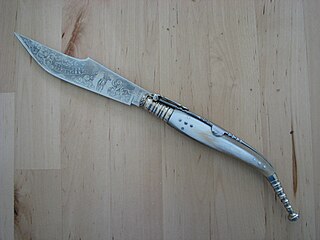 W
WThe navaja is a traditional Spanish folding-blade fighting and utility knife.
 W
WThe Opinel company has manufactured and marketed a line of eponymous wooden-handled knives since 1890 from its headquarters in Saint-Jean-de-Maurienne, Savoie, France — where the family-run company also operates a museum dedicated to its knives. The company sells approximately 15 million knives annually. Opinel knives are made of both high carbon and stainless steel, the latter being the highest quality Sandvik steel from Sweden.
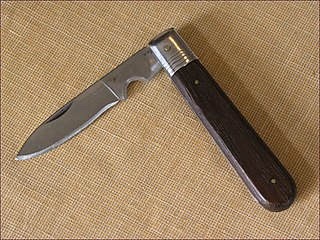 W
WA penknife, or pen knife, is a British English term for a small folding knife. Today the word penknife is the common British English term for both a pocketknife, which can have single or multiple blades, and for multi-tools, with additional tools incorporated into the design.
 W
WThe penny knife dates from the 18th century and was a very basic utility knife, originally with a fixed blade. It received the name penny knife for what it reportedly cost in England and America during the late 18th century: one penny. The famous Fuller's Penny Knife helped build the reputation of Sheffield, England, cutlers in the pre-industrial era of the early 18th century.
 W
WThe resòlza, also known as resòrza, resòrja or arresòja, is a traditional Sardinian folding-blade fighting and utility knife. In Sardinia, this term is widely used to describe all foldable knives.
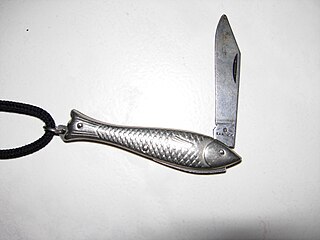 W
WRybička is a small Czech pocket knife with the handle shaped as a fish. It has been produced since the first decades of the 20th century. The knife was particularly popular during the period of socialism in Czechoslovakia. It was valued as a simple and small tool used for mushroom picking, a traditional Czech hobby. It was very popular and sold in large numbers on the Czechoslovak market. As of 2014, it is produced by the company Mikov in Mikulášovice, Czech Republic.
 W
WThe SARK or NSAR is a folding knife designed by knifemaker Ernest Emerson for use as a search and rescue knife by the US military. It has a hawkbill with a blunt tip in order to cut free trapped victims without cutting them in the process. There is a variant with a pointed-tip designed for police, known as the P-SARK.
 W
WThe Sebenza is a folding pocket knife manufactured by Chris Reeve Knives of Boise, Idaho. It is constructed with a stainless steel blade and titanium handle. Its handle functions as the lock mechanism similar in concept to the Walker linerlock differing in that the handle itself forms the lock bar which holds the blade open. This mechanism was invented by Chris Reeve, and is called the Reeve Integral Lock (R.I.L). It is also commonly referred to as the Framelock, and is one of the most widely implemented locking systems in the folding knife industry, where lock strength and reliability is a product requirement. The name Sebenza is derived from the Zulu word meaning "Work," a tribute to Mr. Reeve's South African origins.
 W
WAn OTF Knife, also known as an out-the-front knife, sliding knife, or telescoping knife, is a pocketknife with a blade that opens and closes through a hole in one end of the handle. Contrast this with the majority of knives, which are either standard folding knives or are "fixed blade" sheath knives.
 W
WThe Strider MARSOC SMF is a framelock folding knife that was specifically developed for Detachment 1, the first SOCOM unit of the United States Marine Corps. The Strider SMF was the first knife issued to an individual Marine Corps unit in over 60 years and the first tactical folder issued within the USMC.
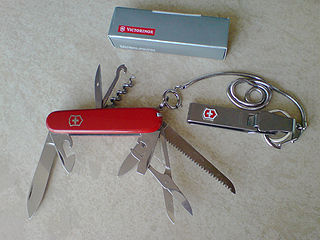 W
WThe Swiss Army knife is a multi-tool pocketknife manufactured by Victorinox. The term "Swiss Army knife" was coined by American soldiers after World War II due to the difficulty they had in pronouncing "Offiziersmesser", the German name.
 W
WA switchblade is a type of knife with a folding or sliding blade contained in the handle which is extended automatically by a spring when a button, lever or switch on the handle or bolster is activated. Most switchblade designs incorporate a locking blade, in which the blade is locked against closure when the spring extends the blade to the fully opened position. The blade is unlocked by manually operating a mechanism that unlocks the blade and allows it to be folded and locked in the closed position.
 W
WThe Umnumzaan is a folding pocket knife manufactured by Chris Reeve Knives of Boise, Idaho, and designed by Chris Reeve. The name "Umnumzaan" is derived from the Zulu language, meaning "Head of the family," or "Boss" (colloq.), a tribute to Mr. Reeve's South Africa origins. The Umnumzaan was designed to meet the needs of operators seeking a heavy-duty folder capable of handling heavy use and even abuse. Building upon the Sebenza’s success, the Umnumzaan features: a stronger pivot joint, a thicker blade, a different blade grind with a reinforced tip, improved ergonomics, thicker titanium handles, a thicker titanium lock bar, a stronger ceramic ball detent system, a larger titanium spacer, a phosphor-bronze washer system designed to act as a ‘dry-sump’ to retain lubrication and keep dirt out, an oversized ambidextrous-thumb studs & extended lock bar to aid operation when wearing gloves, a lanyard pivot joint that uses pivoting lanyard tie bars, and a deeply textured grip.